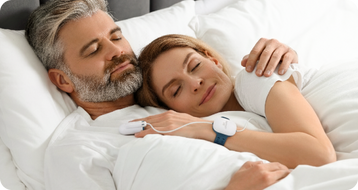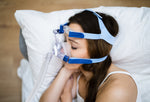On This Page
How to Use a CPAP Machine
Our editorial process includes extensive measures to verify accuracy, provide clarity on complex topics, and present factual information. Read more
Tips for Using a CPAP Machine

- 1 Work with your doctor to find a lightweight, well-fitted mask that feels comfortable, even if it takes some trial and error.
- 2 Wear your mask for short periods while relaxing or watching TV to get used to how it feels.
- 3 Use a CPAP machine with a heated humidifier or try saline sprays to prevent dryness and congestion.
- 4 Experiment with sleeping positions, follow a calming bedtime routine, and talk to your doctor if you have trouble falling asleep.
- 5 Keep your machine clean, place it in a cabinet bedside your bed to reduce noise, and contact your provider if it becomes unusually loud.
Setting Up Your CPAP Machine
Getting your CPAP machine set up properly is the first step toward effective and comfortable therapy. Follow these simple steps to make sure everything is ready for nightly use:
Find the Perfect Spot
Place your CPAP machine on a flat, stable surface near your bed and close to a power outlet. Make sure the vents are unobstructed and the machine is slightly below head level to reduce condensation in the tubing.
Insert the Filter
CPAP machines use a filter that purifies the pressurized air. The type of filter varies based on the model of machine. The original filter should be clean and ready to use as soon as it's inserted for the first time.
Connect the Hose and Mask
Attach the hose to the device on one end and the mask on the other. Be sure that the components are firmly connected to prevent air from leaking out.
Set Up the Humidifier
Add water to the humidifier’s reservoir, but make sure not to go above the “Max Fill” line. The CPAP manufacturer or your doctor may recommend that you only use distilled water in the humidifier.
Depending on the capacity of the reservoir, you may want to have a backup bottle of water nearby in case you need to add water during the night.
Plug It In and Power On
Once assembled, plug in your CPAP machine and turn it on to check airflow. Listen for unusual noises and feel for consistent pressure before putting on your mask.
Putting on Your CPAP Mask
A proper mask fit is key to effective and comfortable CPAP therapy. Taking a few extra moments to adjust your mask before bed can prevent leaks and help you sleep more soundly.
Adjust the Mask
Position your CPAP mask over your nose, mouth, or both (depending on your mask type) and tighten the straps evenly until it feels snug but not restrictive. The mask should stay in place as you move without digging into your skin.
Avoid over-tightening. Pulling the straps too tightly can cause pressure marks, soreness, or air leaks.
Check the Seal
Turn on your CPAP machine and feel around the edges of the mask for escaping air. A good seal keeps air flowing properly and prevents dryness, noise, or therapy interruptions.
Using Your CPAP Machine
Once your CPAP machine is set up and your mask is fitted comfortably, you’re ready to start therapy. Getting used to the sensation of pressurized air can take time, but consistency and patience make a big difference.
Try the Ramp Feature
Some machines let you gradually ramp up the pressure to the prescribed level as you fall asleep. For some people, this ramp setting makes it easier to get to sleep while using CPAP.
Breathe Normally
Try to relax and breathe naturally through your nose or mouth, depending on your mask type. The machine automatically maintains steady airflow to keep your airway open.
Use Every Night
Consistent CPAP use helps your body adapt and ensures you receive the full benefits of CPAP therapy, including reduced snoring, fewer awakenings, and better daytime alertness.
Note: Let your health care provider know if the pressure level is uncomfortable, if the mask or other aspects of using the CPAP are bothersome, or if your CPAP does not seem to be helping your symptoms.
Cleaning and Maintaining Your CPAP
Regular cleaning and maintenance keep your CPAP machine working properly, extend its lifespan, and help prevent irritation or infection. A simple routine makes it easy to stay on track:
- Daily: Wash your mask cushion and tubing in warm, soapy water using a mild, fragrance-free cleanser. Rinse thoroughly and allow all parts to air dry on a clean towel away from direct sunlight.
- Weekly: Clean the humidifier chamber with warm, soapy water and inspect your mask, tubing, and headgear for signs of wear or buildup. Make sure all parts are fully dry before reassembling.
- Filter replacement: Check and clean or replace your CPAP filters according to the manufacturer’s guidelines—typically every two to four weeks for disposable filters and monthly for reusable ones.
- Replace parts as needed: Over time, mask cushions can lose flexibility, tubing can stretch, and headgear can loosen. Replacing CPAP components regularly ensures a secure fit and consistent air pressure delivery.
You may see UV or ozone CPAP cleaners marketed to help you sanitize your equipment, but the U.S. Food and Drug Administration (FDA) warns against these kinds of devices. These products can emit harmful levels of ozone gas or UV light, which may cause respiratory irritation, equipment damage, or other safety risks.
Troubleshooting Common CPAP Problems
Keeping comfortable allows you to get the most out of CPAP therapy. Although people often experience difficulty when they first begin using a CPAP machine, many problems are easy to prevent or fix. Some potential side effects of CPAP therapy include:
- Red, dry, or irritated skin around the mask
- A stuffy or runny nose
- Dry mouth
- Brief pain affecting the chest muscle
- Irritated eyes
It may be tempting to stop using your machine if you have side effects. However, it's important to follow your doctor’s instructions and stick to your treatment plan. If you're experiencing problems, contact your doctor. They can offer tips or solutions to help you use your CPAP machine correctly and comfortably.
For example, you should let your doctor know if your air pressure level is uncomfortably high. They may suggest different approaches to acclimating to the pressure, and if that doesn’t work, they can determine whether to adjust the settings or try a different kind of device.
You should also tell your doctor if you experience anxiety, claustrophobia, discomfort, or air leaks while wearing a mask. They can help identify a type or model of mask that will work best for your needs and preferences.
Tips for Adjusting to Your New CPAP Machine
Getting used to your CPAP machine might take some time. At first, you may feel overwhelmed by the idea of using a CPAP machine every night. But with practice and regular use, the device will become part of your nightly routine and can help you wake up feeling refreshed.
In the meantime, the following tips can help you adjust to your CPAP machine and get better sleep.
- Choose the right mask: Work with your doctor to find a mask that's comfortable. Look for lightweight, cushioned options that fit correctly. It's normal for there to be a process of trial-and-error to find the right mask, so don’t worry if the first ones you try don’t quite work.
- Practice during the day: Try wearing your mask for short periods during the day, such as while you read, watch TV, or do something else relaxing. This can help you get accustomed to the feeling of the mask.
- Keep your nasal passages moist and clear: Look for a CPAP machine with a built-in heated humidifier. Saline nasal sprays or prescription medications may also help with congestion. It may help to increase the humidity in your home.
- Maximize your comfort: Test several sleeping positions ahead of time to find a comfortable position that works for you. Maintain a regular bedtime routine and do something calming before you lay down to sleep. If you have trouble falling asleep, talk to your doctor.
- Limit noise: If the noise from the CPAP bothers you, you can try placing the device in a bedside cabinet. Keeping the CPAP device clean may also reduce how much noise it makes. Let your health care provider know if your CPAP machine seems unusually noisy or damaged in some way.
Frequently Asked Questions
How long does it take to get used to CPAP?
Adjusting to CPAP therapy can take anywhere from a few days to a few weeks. Some people notice improvements in their sleep and energy levels right away, while others need more time to get comfortable with the mask and air pressure.
Using your CPAP every night, starting with the ramp feature, and making small adjustments to your mask or humidity settings can help make the transition easier.
Can I travel with my CPAP machine?
Yes, you can and should bring your CPAP machine when you travel. Most modern CPAP devices are compact, lightweight, and come with a travel case. They are also FAA-approved for in-flight use.
When flying, pack your CPAP as a medical device, which doesn't count toward your carry-on limit. If you travel frequently, consider a travel CPAP machine designed specifically for portability and convenience.
What pressure should my CPAP be set at?
Your CPAP pressure settings are prescribed by your doctor based on the results of your sleep study. Most machines operate within a range of 4 to 20 cm H2O, but your ideal setting depends on the severity of your sleep apnea and your individual breathing needs.
You should never adjust your pressure settings on your own. Always talk to your doctor if your therapy feels uncomfortable or ineffective.
Can I use purified water with my CPAP humidifier?
Distilled water is best for your CPAP humidifier because it prevents mineral buildup and keeps your equipment clean. Purified water can be used very rarely in a pinch, but it may still contain trace minerals that can accumulate in your humidifier chamber over time. For long-term use, stick to distilled water to protect your machine and maintain air quality.









